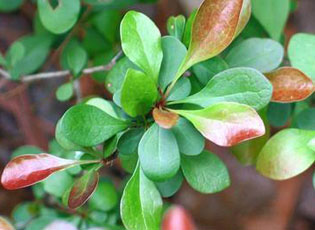August 17, 2016 at 9:19 am
By Wildlife Biologist Joe Wiley
Why should outdoorspeople care about invasive species? Because invasives dramatically affect our outdoor experience in many ways!
First, invasive species outcompete native species. It’s not a fair fight since invasives have many adaptations that allow them to survive and outcompete the native species. Habitats are diminished by losses of diversity when invasives invade. For example, the bush honeysuckles leaf out much earlier than our native honeysuckle. They usually have flowered before most native shrubs leaf out. This can confuse our native pollinators and lead to poor pollinator survival. Our native bumblebees are extremely important for our native flowering plants and even our garden crops.
[caption id="attachment_1854" align="alignleft" width="315"] Japanese barberry foliage - James H. Miller USDA, Forest Service[/caption]
Invasives like Japanese barberry, multi-flora rose, glossy buckthorn and bush honeysuckles can establish and survive under a dense tree canopy. When the canopy is disturbed or removed these invasive species increase rapidly and inhibit native tree regeneration.
Japanese knotweed (bamboo) is an aggressive invader of floodplains and areas next to waterways. It’s especially difficult to control because of its large root system. Often knotweed replaces all the native shrubs and native forbs in the floodplain significantly diminishing habitat suitability for most wildlife.
Black swallowwort is an invasive member of the milkweed family. When Monarch butterfly larvae mistakenly eat the leaves thinking its regular milkweed they die.
Maine’s wildlife thrives on the diversity of habitats the state has. Invasives simplify the habitat and reduce diversity thereby negatively impacting many wildlife species. Amazingly, many invasive species like burning bush (winged euonymus) and Japanese barberry are still available at nurseries and garden centers.
How can you help? Learn to identify the common invasive plants,check your property and implement a control strategy before it’s too late!
For more information, please visit: http://www.maine.gov/dacf/mnap/features/invasive_plants/invasives.htm
Japanese barberry foliage - James H. Miller USDA, Forest Service[/caption]
Invasives like Japanese barberry, multi-flora rose, glossy buckthorn and bush honeysuckles can establish and survive under a dense tree canopy. When the canopy is disturbed or removed these invasive species increase rapidly and inhibit native tree regeneration.
Japanese knotweed (bamboo) is an aggressive invader of floodplains and areas next to waterways. It’s especially difficult to control because of its large root system. Often knotweed replaces all the native shrubs and native forbs in the floodplain significantly diminishing habitat suitability for most wildlife.
Black swallowwort is an invasive member of the milkweed family. When Monarch butterfly larvae mistakenly eat the leaves thinking its regular milkweed they die.
Maine’s wildlife thrives on the diversity of habitats the state has. Invasives simplify the habitat and reduce diversity thereby negatively impacting many wildlife species. Amazingly, many invasive species like burning bush (winged euonymus) and Japanese barberry are still available at nurseries and garden centers.
How can you help? Learn to identify the common invasive plants,check your property and implement a control strategy before it’s too late!
For more information, please visit: http://www.maine.gov/dacf/mnap/features/invasive_plants/invasives.htm
 Japanese barberry foliage - James H. Miller USDA, Forest Service[/caption]
Invasives like Japanese barberry, multi-flora rose, glossy buckthorn and bush honeysuckles can establish and survive under a dense tree canopy. When the canopy is disturbed or removed these invasive species increase rapidly and inhibit native tree regeneration.
Japanese knotweed (bamboo) is an aggressive invader of floodplains and areas next to waterways. It’s especially difficult to control because of its large root system. Often knotweed replaces all the native shrubs and native forbs in the floodplain significantly diminishing habitat suitability for most wildlife.
Black swallowwort is an invasive member of the milkweed family. When Monarch butterfly larvae mistakenly eat the leaves thinking its regular milkweed they die.
Maine’s wildlife thrives on the diversity of habitats the state has. Invasives simplify the habitat and reduce diversity thereby negatively impacting many wildlife species. Amazingly, many invasive species like burning bush (winged euonymus) and Japanese barberry are still available at nurseries and garden centers.
How can you help? Learn to identify the common invasive plants,check your property and implement a control strategy before it’s too late!
For more information, please visit: http://www.maine.gov/dacf/mnap/features/invasive_plants/invasives.htm
Japanese barberry foliage - James H. Miller USDA, Forest Service[/caption]
Invasives like Japanese barberry, multi-flora rose, glossy buckthorn and bush honeysuckles can establish and survive under a dense tree canopy. When the canopy is disturbed or removed these invasive species increase rapidly and inhibit native tree regeneration.
Japanese knotweed (bamboo) is an aggressive invader of floodplains and areas next to waterways. It’s especially difficult to control because of its large root system. Often knotweed replaces all the native shrubs and native forbs in the floodplain significantly diminishing habitat suitability for most wildlife.
Black swallowwort is an invasive member of the milkweed family. When Monarch butterfly larvae mistakenly eat the leaves thinking its regular milkweed they die.
Maine’s wildlife thrives on the diversity of habitats the state has. Invasives simplify the habitat and reduce diversity thereby negatively impacting many wildlife species. Amazingly, many invasive species like burning bush (winged euonymus) and Japanese barberry are still available at nurseries and garden centers.
How can you help? Learn to identify the common invasive plants,check your property and implement a control strategy before it’s too late!
For more information, please visit: http://www.maine.gov/dacf/mnap/features/invasive_plants/invasives.htmCategories